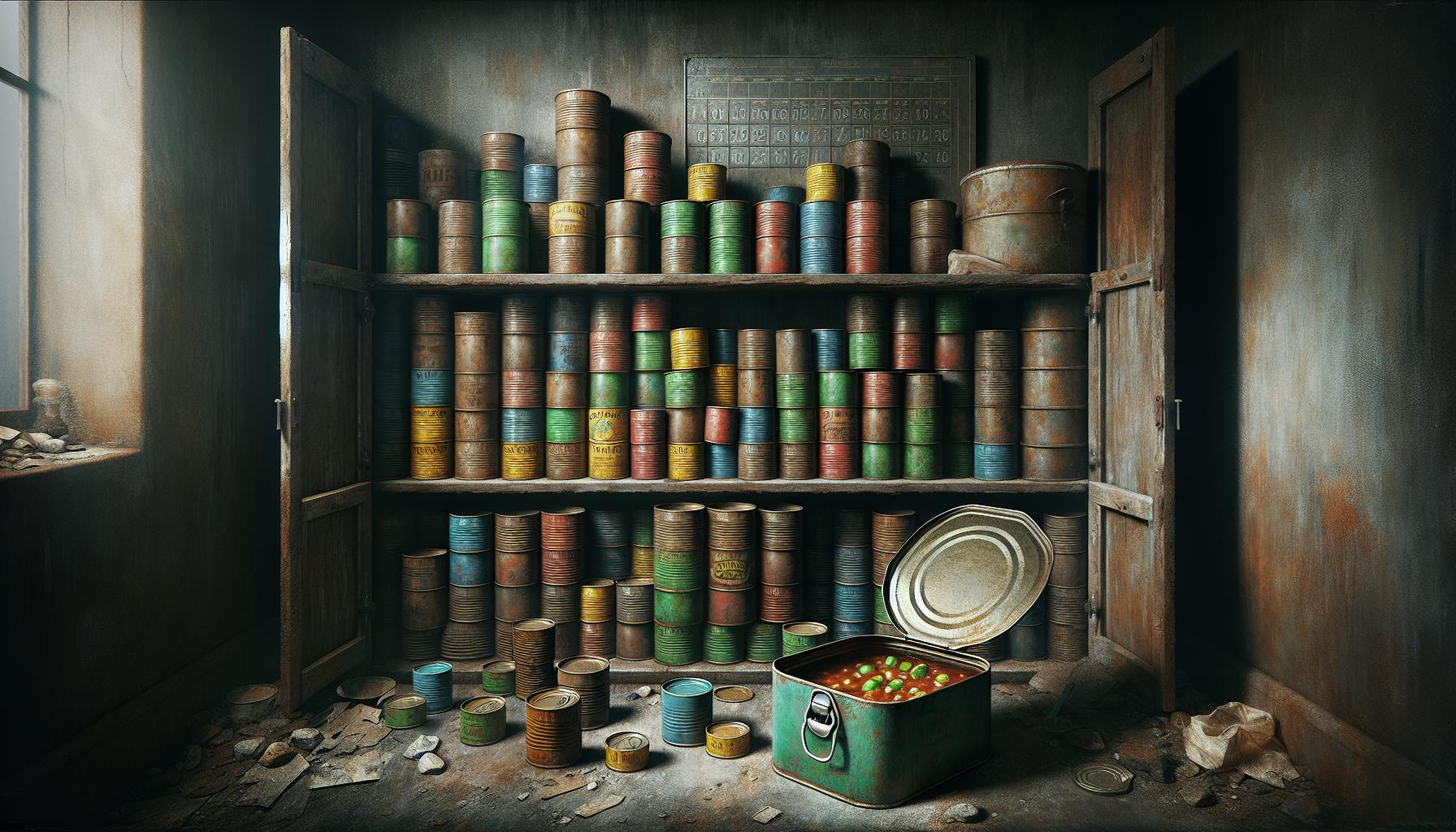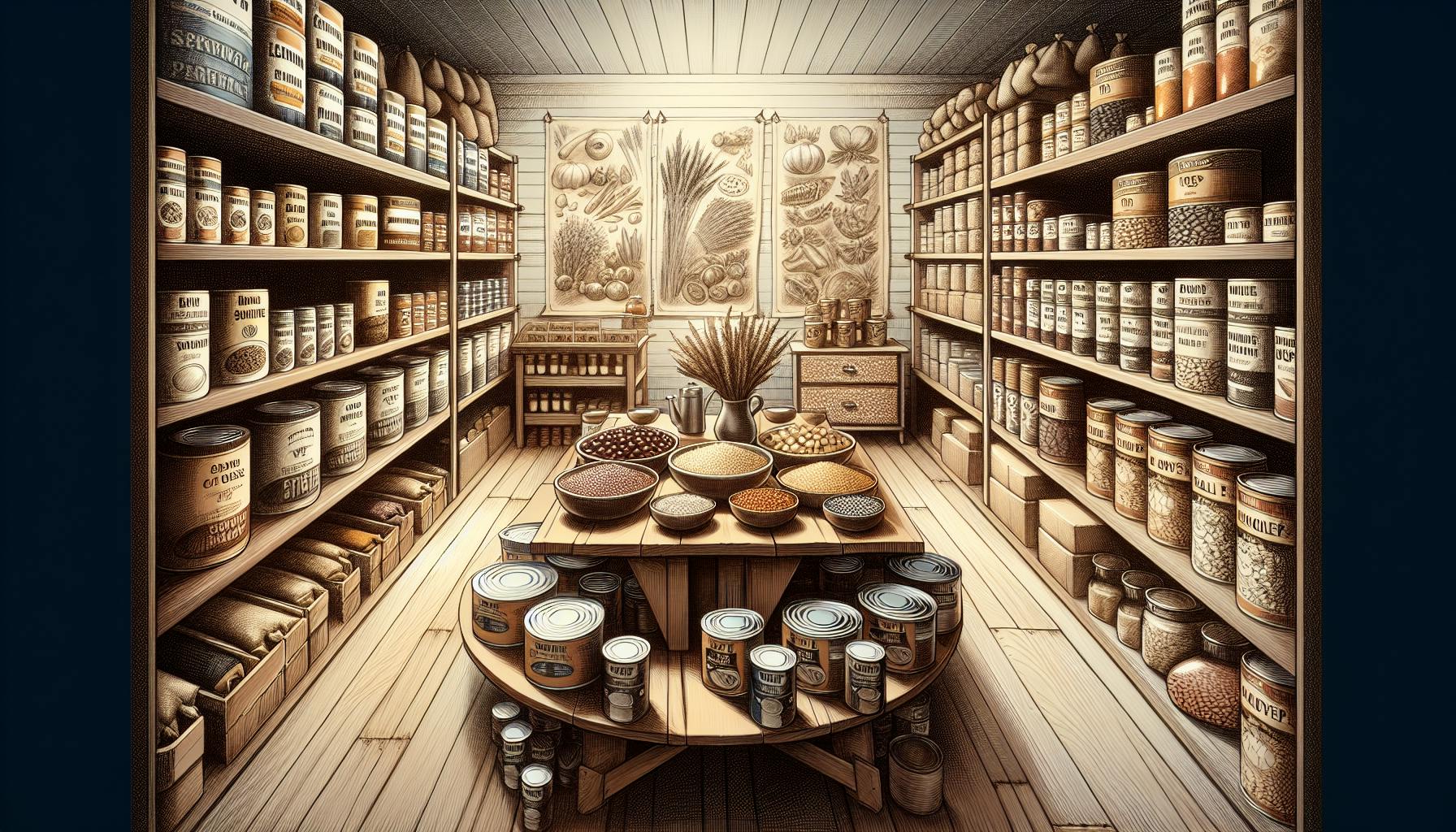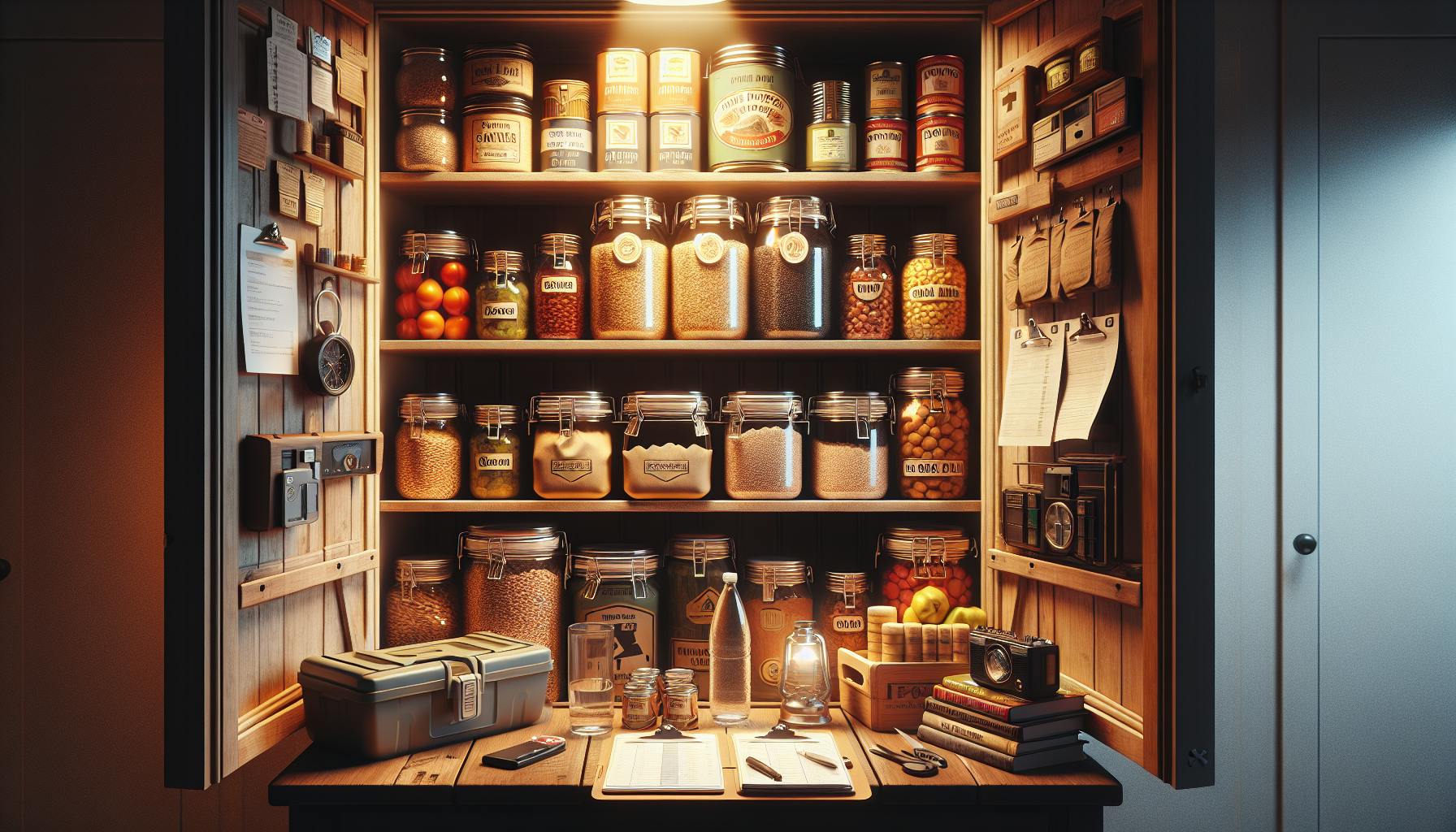Preparing for emergencies on a budget can be challenging.
This comparison of the cheapest survival food kits breaks down affordable options to help you maximize value and preparedness.
We'll evaluate budget-friendly kits for 72-hour, 30-day, and 1-year supplies, including pros and cons of items like Wise emergency buckets, Augason Farms, and SHTF kits. You'll get tips to assemble your own custom kit too.
Introduction to Emergency Preparedness Food
Being prepared for emergencies with survival food kits provides peace of mind. When choosing an emergency food supply, affordability is key. This article compares budget-friendly options to find the cheapest survival food kits that still meet nutritional needs.
Understanding Survival Food Kits Essentials
Survival food kits contain non-perishable food and water to sustain a person or family during emergencies like natural disasters or power outages. When choosing affordable emergency food, key factors include shelf life, nutritional value, taste, and quantity. Those with specialized diets, like gluten-free or diabetic, should ensure their survival food meets their needs. Affordable options still provide essential nutrition if chosen carefully.
Evaluating Budget-Friendly Survival Food Kits
When comparing cheapest survival food kits, consider:
- Nutrition: Food should contain balanced macronutrients with vitamins and minerals. Prioritize protein, fiber and healthy fats.
- Taste: Food should be palatable, especially for children. Sample tastes when possible.
- Shelf life: Look for 5+ year expiration dates. Store in cool, dark spaces to maximize freshness.
- Packaging: Items should be sealed in durable, waterproof packaging. Mylar pouches are optimal for portability.
- Quantity: Kits should contain enough calories per day for each person. Estimate minimums around 1,200 calories.
- Allergens: Check for common allergens like gluten, dairy and nuts if needed.
- Budget: Compare calorie-per-dollar across kits to maximize value. Consider group buying for additional savings.
The Role of 72-Hour Emergency Kits in Disaster Preparedness
Experts recommend having a 72-hour emergency kit for each person that includes:
- Water (1 gallon per person per day)
- Non-perishable food (at least 1,200 calories per person daily)
- First aid supplies
- Flashlights, radio, batteries
- Basic toiletries and clothing
- Copies of important documents
- Cash
Having an emergency supply on hand eases hardship during disasters when access to food and water is disrupted.
Affordable Emergency Food: Balancing Cost and Quality
When selecting a budget-friendly survival food kit, balance cost savings with nutritional value, taste, and your household’s needs. Sample affordable options to determine if quality and taste are acceptable before fully stocking up. Favor kits with a variety of nutrient-dense foods over repetitive staples like rice and beans. Check expiration dates, storing in optimal conditions to maximize shelf life and value. Prepare your household with quality emergency provisions without overspending.
What is the best food to stock up on for survival?
When building your emergency food supply, focus on non-perishable foods that provide nutrients and calories to sustain you in a crisis. Here are some of the best options to stock up on:
Canned and Jarred Foods
- Canned vegetables, fruits, meats, and seafood last 2-5 years unopened. Opt for low sodium versions.
- Canned chili, ravioli, soups, and stews are convenient, budget-friendly options.
- Nut butters, jams, honey, and maple syrup provide carbs, flavor, and nutrients.
Dried and Dehydrated Foods
- Rice, pasta, oats, flour, and dried beans are inexpensive sources of calories and fiber.
- Dried fruits, coconut flakes, and raisins add sweetness.
- Beef and turkey jerky, dried seafood, and pemmican are protein-packed options.
Other Essentials
- Vegetable, olive, coconut, and avocado oils for cooking.
- Vinegars, mustards, hot sauces, and salad dressings to liven up meals.
- Nuts, seeds, granola, and trail mixes for snacking.
- Powdered milk, eggs, or meat for added nutrition.
When stocking up, think about nutritional balance across food groups. Also factor in dietary needs, cooking fuel available, and space for storage. With some planning, you can build an ample emergency food supply on a budget.
Are emergency food buckets worth it?
Emergency food buckets can provide convenient, long-lasting food storage, but they have some drawbacks to consider:
Nutritional adequacy
- Food buckets are designed for calories, not comprehensive nutrition. Vitamin/mineral deficiencies may occur with long-term reliance.
- Adding supplemental foods like fruits, vegetables, and proteins is recommended for balanced nutrition.
Taste and variety
- Freeze-dried and dehydrated foods can lack appetizing textures and flavors.
- Spices, sauces, and mixing kits can improve taste, but variety is still limited.
Cost
- Buckets with full nutritional profiles tend to be more expensive.
- Building your own emergency food supply allows more budget-friendly customization.
Storage conditions
- Food buckets require cool, dry, dark storage to maximize shelf life. Improper storage can lead to spoilage.
- Storing smaller quantities in multiple locations helps mitigate risk of spoilage.
Overall, food buckets can serve a purpose for short-term emergency supply, but should not replace comprehensive nutritional planning for long-term crises. Supplementing buckets with other foods is essential. Compare brands and contents carefully when purchasing.
What is the best shelf life emergency food?
When building an emergency food supply, it's important to focus on shelf-stable foods with a long shelf life. Some good options to consider include:
Canned Goods
Canned goods like fruits, vegetables, beans, meat, and fish can last 2-5 years unopened. Canned goods are budget-friendly and don't require special storage. Just make sure to get low sodium options.
Dried Goods
Dried pasta, rice, oats, and beans can last up to 30 years when properly stored. Opt for whole grains whenever possible.
Freeze-Dried Food
Freeze-dried meals and fruits have a shelf life of 25+ years. Though pricier than other options, they're lightweight and convenient.
MREs
Meals Ready-to-Eat (MREs) are self-contained, shelf-stable meals created for the military. Civilian MREs last 5+ years.
When building your emergency food supply, focus on nutrient-dense, budget-friendly options with long shelf lives. Canned goods, dried goods, freeze-dried foods, and MREs are all good candidates. Just be sure to take storage conditions and expiration dates into account.
sbb-itb-b932644
How do I make my own survival food supply?
When creating your own survival food supply, it's important to include nutrient-dense non-perishable foods that will sustain you in an emergency. Here are some budget-friendly options to consider:
Canned and Dried Goods
Focus on canned or dried fruits, vegetables, beans, meats, and seafood. Opt for low-sodium versions when possible. Some good choices are:
- Canned tuna, salmon, chicken
- Canned beans, vegetables, fruits
- Whole grains like brown rice, quinoa, oats
- Dried fruits and nuts
Comfort Foods
Having some familiar comfort foods on hand can lift spirits in stressful times. Some affordable options include:
- Peanut butter
- Jelly, honey, syrup
- Crackers
- Granola bars
- Powdered milk
- Bouillon cubes
- Herbs and spices
Drinks
Staying hydrated is crucial. Have plenty of water plus some variety:
- Canned juices
- Powdered sports drinks
- Tea bags
- Instant coffee
Rotate and replace food items before they expire. Consider creating a 72-hour emergency kit as a starting point. With some planning, you can put together a cost-effective, long-lasting survival food supply to weather any storm.
Cost-Effective Survival Kits on the Market
Comparing affordable, ready-made survival food kits can help identify options that provide good value for budget-conscious preppers. When evaluating cost-effective kits, key factors to consider include nutritional content, shelf life, taste, preparation requirements, and components included.
Wise Company Emergency Food Kit: A Survival Food Comparison
The Wise Company emergency food kit provides a budget-friendly option with a 25-year shelf life. Each pouch contains meals with an average of 300 calories and 7-15g of protein. Reviews indicate the food tastes relatively good for freeze-dried meals, though some flavors are better than others. For the low price point, this kit offers good nutritional content and long shelf life. Easy preparation with just boiling water is a plus. On the downside, some pouches contain common allergens like soy and dairy.
Augason Farms: Affordable Emergency Food with Long Shelf Life
Augason Farms emergency food kits offer a great value with a 20-30 year shelf life. The breakfast and entree pouches have 300-400 calories per serving with 7-20g of protein. Most meals only require water, though some need milk and oil. Reviews praise the better-than-average taste for long shelf life food. The 30-day supply kit has a good variety of grains, veggies, fruits and meats. Those with dietary restrictions should note that many meals contain common allergens. Overall, this kit has quality ingredients and nutritional stats at a competitive price point.
SHTF Survival Bucket: Budget-Friendly 30-Day Food Supply
The SHTF Survival bucket keeps costs low by utilizing #10 cans to store staples like rice, beans, oats, pasta and baking mix rather than pre-made meals. This requires more preparation compared to kits with ready-to-eat pouches. Each bucket provides over 5,200 servings with 98,700 calories total. As a budget option focused on staples, it lacks variety and nutritional components like fruits and vegetables. Reviews indicate taste and texture varies between ingredients. Those wanting easy, ready-to-eat meals may prefer other kits, but the SHTF Survival bucket does offer an extremely affordable 30-day supply.
1-Person Emergency Kit Essentials: Affordable Options
For 72-hour emergency kits for one person, the Redfora and Wakaga kits both provide good value. The Redfora kit contains 18 food bars with 400 calories each, while the Wakaga has pouches with meals averaging 300 calories. Both include food and water for 3 days, along with other essentials like blankets and first aid kits. The Redfora kit costs slightly less at $60 compared to $80 for the Wakaga kit. However, the Wakaga meals offer more comfort food variety. Solo preppers should consider their budget, taste preferences and desired components when choosing between these quality, affordable options.
Long Shelf Life Food: Identifying Value in Survival Food Kits
When evaluating which budget-friendly survival food kits offer the longest shelf life, both Augason Farms and Wise Company deliver excellent value. Their food pouches and ingredients often maintain a 20-30 year shelf life without compromising on quality, nutrition or taste. This compares very favorably to many competitors that may only guarantee a 1-5 year shelf life for similar ready-to-eat meals. For the most cost-effective emergency food with decades-long expiration dates, Augason Farms and Wise Company both fit the bill.
Creating a Basic Survival Food Supply on a Budget
Planning Your Budget-Friendly Survival Kit
When creating a budget-friendly survival kit, the first step is assessing your needs. Consider factors like how many people you are preparing for, any dietary restrictions, evacuation scenarios, and length of time you may need supplies. Once you've determined your needs, set a realistic budget based on what you can afford.
Next, research your options for affordable survival foods and supplies. Look into bulk retailers, dollar stores, military surplus stores, and online preparedness shops. Compare prices to find the best values on items like rice, beans, oats, peanut butter, canned meat and veggies, first aid kits, flashlights, and batteries.
It's also important to map out balanced meal plans covering breakfast, lunch, and dinner. Focus on nutritious, filling foods that don't require refrigeration and have a long shelf life.
Selecting Affordable Long Shelf Life Foods
Some of the most budget-friendly survival foods that also offer long shelf lives include:
- Rice and beans: Inexpensive source of carbohydrates, fiber, and plant-based protein. Store up to 30 years.
- Instant oats or oat groats: Quick breakfast, high in fiber. Last 1-2 years.
- Canned fruits, vegetables, soups: Affordable, store 2+ years. Seek low-or-no sodium options.
- Peanut butter: Rich in protein, vitamins. Keeps 3-5 years unopened.
- Canned meats like tuna, chicken, salmon: Protein sources with 5+ year shelf life.
- Vegetable oils: Essential cooking ingredient, lasts 2-3 years properly stored.
- Pasta: Budget-friendly carbs, keeps 1-2 years. Pair with canned sauce.
When buying canned goods, carefully inspect that cans are free of damage, rust, or dents.
Budget Sources for Emergency Supplies
Check these places to find deals on supplies to round out your 72-hour kit or other emergency preparations:
- Dollar stores: For flashlights, batteries, first aid items, tools, and hygiene products.
- Military surplus stores: Offer sturdy bags/packs, MREs, camping gear for less.
- Big box stores: Shop sales on storage containers, camping supplies, shelf-stable groceries.
- Online: Sites like Amazon offer bulk pricing on tools, radios, water storage.
Assembling a 72-Hour Emergency Kit with Cost-Effective Items
With the affordable food and critical supplies, you can assemble customized 72-hour kits for your household. Essentials to include:
- 3 days worth of meals and snacks per person
- 3 gallons of water per person
- First aid kit and medications
- Flashlight, radio, batteries
- Multi-tool, duct tape
- Personal hygiene items
- Emergency blankets, ponchos
- Cash, copies of important documents
The key is covering basic survival needs like food, water, first aid, communication, shelter, sanitation, and key documents. With smart sourcing and budgeting, this lifesaving preparation is within reach for every household.
Specialized Budget-Friendly Survival Kits
Gluten-Free Survival Food Options
When assembling a survival food kit on a budget, those with gluten intolerance or celiac disease may need to take extra steps to ensure their emergency provisions meet their dietary restrictions. Some key gluten-free options to consider include:
- Canned fruits, vegetables, beans, meats, fish - make sure to check labels for gluten-containing ingredients. Prioritize certified gluten-free when possible.
- Rice, quinoa, buckwheat, cornmeal, potato flakes - versatile gluten-free grains.
- Nuts, seeds, nut butters, dried fruit - healthy portable options.
- Gluten-free protein bars or meal replacement shakes - easy sources of protein and nutrients.
- DIY trail mixes and granola - customize ingredients to avoid gluten.
Building your own gluten-free survival food kit allows you to control ingredients and better meet specialized needs. Having an emergency supply that aligns with your normal diet also minimizes disruption if disaster strikes.
Affordable Diabetic Emergency Food Supply
Those living with diabetes face the additional challenge of regulating blood sugar when building an emergency food supply. Some budget-friendly tips include:
- Stock up on items naturally lower in carbs - proteins, healthy fats, non-starchy veggies.
- Choose whole, minimally processed options whenever possible.
- Mix in some sugary items like juice boxes or candy for hypoglycemia.
- Include diabetes medication and testing supplies.
- Store extra food as blood sugar levels may run higher under stress.
Keeping an emergency supply similar to your normal diabetic diet helps ease transition in crisis situations. Consult your doctor for advice tailoring your kit to your health needs.
Budget Emergency Food for Babies and Children
Providing for babies, toddlers and children during disasters requires some age-specific considerations:
Babies
- Formula, bottles, nipples, sterilization equipment.
- Jarred baby food, pouches, infant cereal.
- Extra diapers, wipes, rash cream.
Toddlers
- Shelf-stable milk, pediatric electrolyte drinks.
- Easy-to-eat finger foods - soft granola bars, crackers, raisins.
- Comfort items - snacks, juice boxes.
Children
- Kid-friendly canned goods - pasta, soups, veggies.
- Granola bars, fruit snacks, peanut butter.
- Foods to boost morale - pudding cups, Jell-O, candy.
Tailor kits to ages and make sure to include comfort foods when possible. Check expiration dates regularly when stocking kids' emergency food.
Survival Food Kits for Special Diets: Pros and Cons
Pros
- Targeted nutrition for health conditions.
- Minimized disruption adjusting to emergency food.
- Peace of mind needs will be met.
Cons
- Typically smaller market so options are limited.
- Often pricier than standard kits.
- Short expiration dates on some specialty products.
- Can require extra preparation tailoring supplies.
While specialized diet emergency kits have added challenges, the benefit of having provisions suited to your needs often outweighs any downsides. Evaluate your budget, health priorities and pack preferences when deciding on the best survival food supply for you.
Conclusion: Maximizing Survival Food Value and Preparedness
Recap of the Most Affordable Survival Food Kits
When looking for an affordable survival food kit, focus on finding options that provide adequate calories and nutrients to support your needs during an emergency, at the lowest possible cost. Some top budget-friendly picks include:
- Wise Company 60-Serving Grab-and-Go Food Kit ($50) - Compact and lightweight grab-and-go meals.
- Augason Farms 30-Day Emergency Food Supply ($100) - 1-month supply with breakfasts, entrées, vegetables, and snacks.
- Mountain House Just in Case 72-Hour Kit ($60) - Enough food and water for 3 days for one person.
- SOS Food Labs Emergency Food Rations ($40) - 3-day supply of compact nutrient bars.
The key is balancing affordability with sufficient nutrition, calories, and variety to maintain health.
Tips for Assembling a Custom Budget-Friendly Kit
To save even more money, make your own custom survival kit:
- Focus on nutritious, non-perishable staples like rice, beans, oats, peanut butter, etc.
- Shop sales and buy in bulk quantities whenever possible.
- Portion into mylar bags or storage containers with oxygen absorbers to maximize shelf life.
- Supplement with affordable survival food bars for convenience.
With some planning, you can assemble a 1-month supply for one person for around $150.
Final Thoughts on Specialized Budget Kits
Those with specialized diets or needs may pay more for gluten free, diabetic friendly, or allergen free survival food. But many standard options can be adapted:
- Choose kits with a variety of base ingredients that can be separated for restricted diets.
- Swap out problem ingredients for suitable substitutes.
Get creative to supply critical nutrition at the lowest cost.
Emergency Preparedness on a Budget: Key Takeaways
Focus on securing the staples for survival first in an affordable way. Then build up supplies over time as budget allows until you have a well-stocked, nutritionally complete food reserve tailored to your situation. With some savvy shopping and customization, emergency preparedness is possible even on a tight budget.


